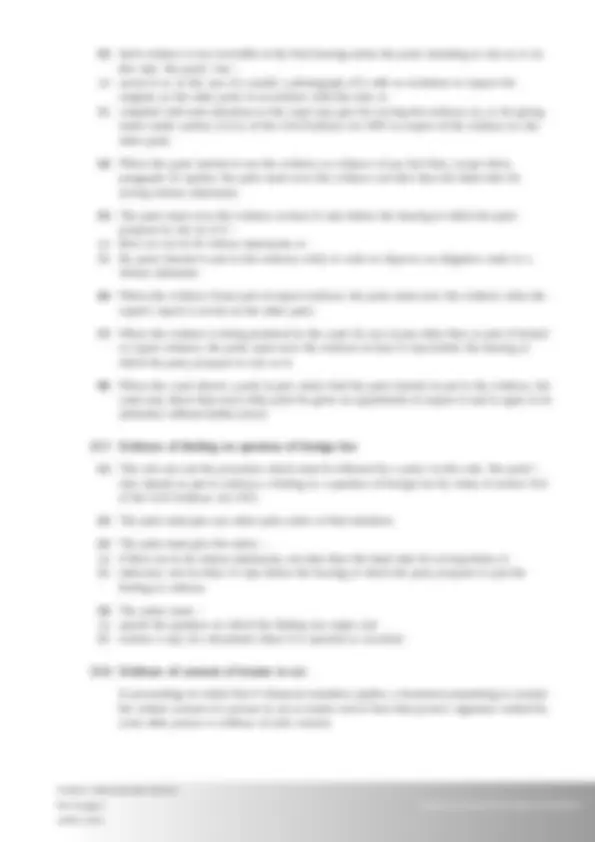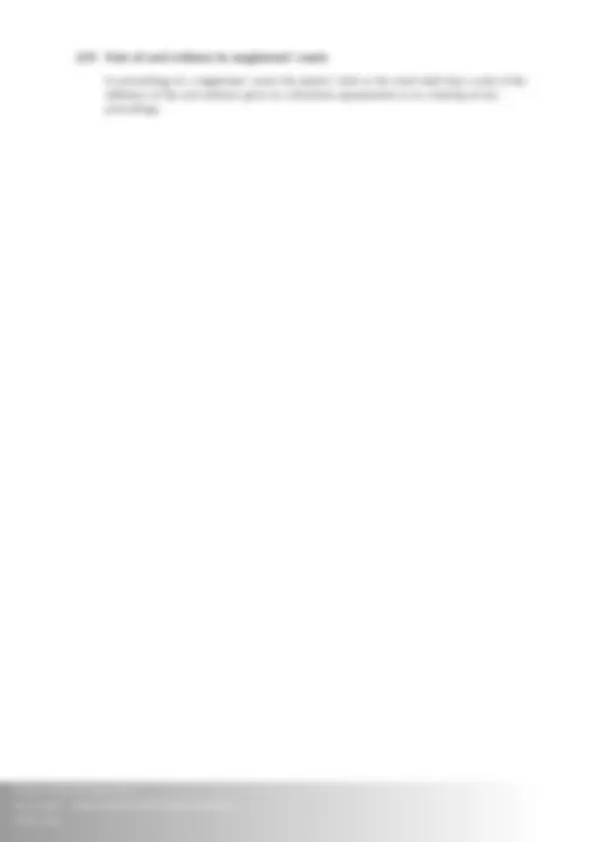




Study with the several resources on Docsity

Earn points by helping other students or get them with a premium plan


Prepare for your exams
Study with the several resources on Docsity

Earn points to download
Earn points by helping other students or get them with a premium plan
Community
Ask the community for help and clear up your study doubts
Discover the best universities in your country according to Docsity users
Free resources
Download our free guides on studying techniques, anxiety management strategies, and thesis advice from Docsity tutors
The rules regarding hearsay evidence in family proceedings as outlined in the family procedure rules of april 2011. Topics covered include the requirement to give notice of intention to rely on hearsay evidence, exceptions to this requirement, the power to call a witness for cross-examination on hearsay evidence, and the use of plans, photographs, and models as evidence. The document also covers the procedures for providing evidence of foreign law and consent of trustees.
Typology: Study notes
1 / 4

This page cannot be seen from the preview
Don't miss anything!



Rule 23.1 Scope and interpretation of this Part Rule 23.2 Notice of intention to rely on hearsay evidence Rule 23.3 Circumstances in which notice of intention to rely on hearsay evidence is not required Rule 23.4 Power to call witness for cross-examination on hearsay evidence Rule 23.5 Credibility Rule 23.6 Use of plans, photographs and models etc as evidence Rule 23.7 Evidence of finding on question of foreign law Rule 23.8 Evidence of consent of trustee to act Rule 23.9 Note of oral evidence in magistrates’ courts
Rules 23.2 to 23.6 apply to evidence to which the Children (Admissibility of Hearsay Evidence) Order 1993^1 does not apply.
(1) Where a party intends to rely on hearsay evidence at the final hearing and either – (a) that evidence is to be given by a witness giving oral evidence; or (b) that evidence is contained in a witness statement of a person who is not being called to give oral evidence, that party complies with section 2(1)(a) of the Civil Evidence Act 1995^2 by serving a witness statement on the other parties in accordance with the court’s directions.
(2) Where paragraph (1)(b) applies, the party intending to rely on the hearsay evidence must, when serving the witness statement – (a) inform the other parties that the witness is not being called to give oral evidence; and (b) give the reason why the witness will not be called.
(3) In all other cases where a party intends to rely on hearsay evidence at the final hearing, that party complies with section 2(1)(a) of the Civil Evidence Act 1995 by serving a notice on the other parties which – (a) identifies the hearsay evidence; (b) states that the party serving the notice proposes to rely on the hearsay evidence at the final hearing; and (c) gives the reason why the witness will not be called.
(4) The party proposing to rely on the hearsay evidence must –
1 S.I. 1993/621. 2 1995 c.38.
PA RT 23
F AMILY PROCEDURE RU LES Part 23 page 1 MISCELLANEOUS RULES ABOUT EVIDENCE
(a) serve the notice no later than the latest date for serving witness statements; and (b) if the hearsay evidence is to be in a document, supply a copy to any party who requests it.
Section 2(1) of the Civil Evidence Act 1995 (duty to give notice of intention to rely on hearsay evidence) does not apply – (a) to evidence at hearings other than final hearings; (b) to an affidavit(GL)^ or witness statement which is to be used at the final hearing but which does not contain hearsay evidence; or (c) where the requirement is excluded by a practice direction.
(1) Where a party – (a) proposes to rely on hearsay evidence; and (b) does not propose to call the person who made the original statement to give oral evidence, the court may, on the application of any other party, permit that party to call the maker of the statement to be cross-examined (GL)^ on the contents of the statement.
(2) An application for permission to cross-examine (GL)^ under this rule must be made within 14 days beginning with the date on which a notice of intention to rely on the hearsay evidence was served on the applicant.
(Rules 35.3 and 35.4 contain rules in relation to evidence arising out of mediation of cross- border disputes.)
(1) Where a party proposes to rely on hearsay evidence, but – (a) does not propose to call the person who made the original statement to give oral evidence; and (b) another party wishes to call evidence to attack the credibility of the person who made the statement, the party who so wishes must give notice of that intention to the party who proposes to give the hearsay statement in evidence.
(2) A party must give notice under paragraph (1) within 14 days after the date on which a hearsay notice relating to the hearsay evidence was served on that party.
(1) This rule applies to – (a) evidence (such as a plan, photograph or model) which is not – (i) contained in a witness statement, affidavit (GL)^ or expert’s report; (ii) to be given orally at the final hearing; or (iii) evidence of which prior notice must be given under rule 23.2; and (b) documents which may be received in evidence without further proof under section 9 of the Civil Evidence Act 1995.
(2) Except as provided below, section 2(1)(a) of the Civil Evidence Act 1995 (notice of proposal to adduce hearsay evidence) does not apply to evidence falling within paragraph (1).
FA MILY P ROCEDURE RULES Part 23 page 2 MISCELLANEOUS RULES ABOUT EVIDENCE
In proceedings in a magistrates’ court, the justices’ clerk or the court shall keep a note of the substance of the oral evidence given at a directions appointment or at a hearing of any proceedings.
FA MILY P ROCEDURE RULES Part 23 page 4 MISCELLANEOUS RULES ABOUT EVIDENCE